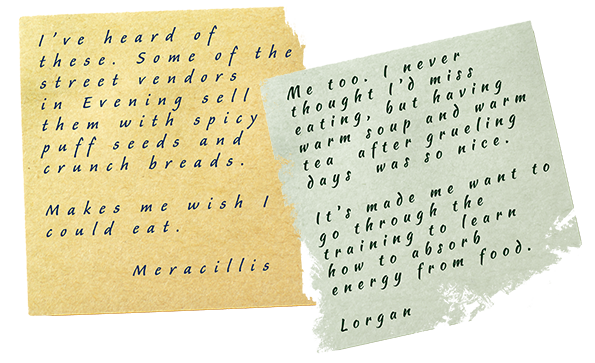Lorgan's Notes: Snake's Den Skewers
The Snake's Dena is known for its scarcity in food and water. The desert is not a hospitable environment, by any means. Ghosts will have difficulty finding enough mist to absorb, and, as a Finder, you will need to feed your living guides. This is why you need to know about Snake Skewers.
Research:
Snake's Den Skewers
Snake's Den Skewers
by our hungry hero, Lorgan the ravenous
In this Research Document:
all images by Shanda Nelson
unless otherwise stated
unless otherwise stated
Brief History
After the dryan disaster, food and water became a scarce commodity. Of course, the living populations still needed those things, for themselves and their animals. Flora and fauna died out, and communities turned nomadic, searching for their next source of food and water.
Because edibles were so far away from one another, the nomads needed a way to store food, and quite the disparate foodstuffs at that.
Some enterprising being developed the Snake skewer as a way to keep dried foods together and ready for consumption (there is some evidence that the ancestors of the current Voristi started this tradition, but don't tell the Nevemere that).

Nikolaydonetsk, Envato Elements
Skewers
Dear Finders, skewers are an imporant desert meal. You need to know about them, for the sake of any living being with you on your trip into the arid Snake's Den interior. Basically, whatever food you find, goes on a skewer. These are long, thin sticks made from gnarled rocky tree--and it needs to be gnarled rocky tree wood, because of the magic used to dry them. Fill it up, with whatever you can find. This can include fruits, vegetables, edible flowers, insects, meat from wild game and birds (the seashore nomads have their own version, with fish and shellfish and seaweed). Skewers are typically a mix, and include at least a couple of pieces of fruit because of the water content. Don't use viscera and other organs, however. Those are prepared in a different manner, for a different type of meal.
Now comes the fun part. Set the raw skewers on a flat ceramic plate, not touching. Whatever magisi is with you will conduct a short ritual that basically preserves the food through a drying spell (and if you ask nicely, they will teach it to you).
It's a strange drying spell. It sizzles and an orange haze coates the items, but only dries the outer skin, leaving the insides raw and moist. I have no idea why they don't rot, but they don't (unless you add viscera. Don't add viscera).
The skewers are then placed within a darkweed basket--and only a darkweed basket--layers covered with a thin, woven canny cloth, and kept there until ready for consumption (they are preserved for up to four Evenacht seasons!). Cooks place the skewers on a stand-alone grill top over a campfire. The skins pop and the skewer catches fire for a brief moment, triggering the magic. This magic cooks the meal, crisping meat and vegetables, but only heating fruits, retaining the moisture within.
Gnarled rocky tree wood smokes when the spell is released, but will not burn. Other woods do, which ruins the skewers. They fall apart, sometimes into the fire, or leave piles of ash inside the chunks.
Don't touch the skewers while they're cooking. The magic zaps ghostly essences and will suck you into the food. That, obviously, isn't appealing to anyone.
Different nomadic clans have different patterns they make with skewer foods. One can often tell from which group they hail by the numbers of meats, fruits and vegetables placed in certain orders, which dictates the length of the skewers, another indication of clan association. Sometimes color plays a role, but because the beings collect edibles from whatever is available, it's rarely connotative.
The patterns are ideals; the real skewers rarely are.
The most important part of a skewer is the fruit, due to the water content. The desert peoples tend to use a few pieces of fatwater in every skewer. Fatwater is a red, fleshy succulent fruit the size of your head, and it holds more water than you think. It's one of the most farmed crops in rural desert landed communities, and mostly sold to the traveling bands rather than kept in-community.





I love this great idea of preserving the ingredients and your descriptions of the process. I also like these little hints to the reader about what to do and what not to do. Also, I might snag your tooltop photo idea ;-)
thanks! Yeah, snag away. The tooltip with picture comes in pretty handy, when you don't necessarily want the image to take up space at that point in the article.